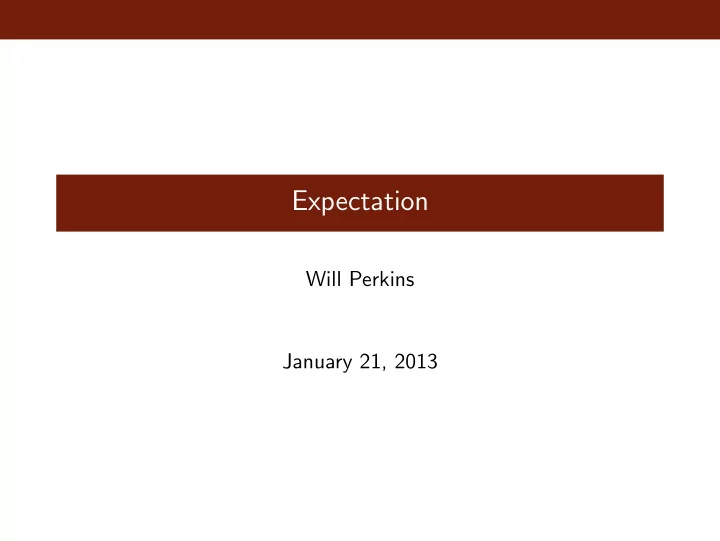

Expectation Will Perkins January 21, 2013
Expectation Definition The expectation of a random variable X on a probability space (Ω , F , P ) is: � E ( X ) = X ( ω ) dP ( ω ) Ω
Change of Variables Often we think of a random variable without explicitly defining the probability space on which it lies. We can still compute its expectation using the formula: � E ( X ) = x dF X ( x ) R where dF X ( x ) is the distribution of X ; i.e. the measure on R induced by the random variable X , with the Borel σ -field of R , and generated by dF X (( −∞ , x ]) = F ( x )
Functions of X Similarly we can define the expectation of any function of X . Say g : R → R is a measurable function. Then we define � E ( g ( X )) = g ( x ) dF ( x ) R � = g ( X ( ω )) dP ( ω ) Ω
Properties of Expectation Some basic properties of expectation that follow from the properties of abstract integration: 1 Linearity: E ( aX + bY ) = a E X + b E Y . 2 Monotonicity: if X ≥ Y a.s., then E X ≥ E Y . 3 Jensen’s Inequality: Let f : R → R be a convex function. Then f ( E X ) ≤ E ( f ( X ))
Examples Let X be the indicator random variable of an event A . Then E X = 1 · Pr( A ) + 0 = Pr( A ).
Examples Poisson Distribution: Let X ∼ Pois ( λ ). E X =?
Examples Poisson Distribution: Let X ∼ Pois ( λ ). E X =?
Examples Continuous RV’s: Let X ∼ Uniform [0 , 1]. E X =?
Examples Binomial Distribution: Let X ∼ Bin ( n , p ). E X =? Use Linearity of Expectation. The power of linearity is that dependencies don’t matter .
Expectation of Counting Random Variables Counting random variables are somewhat special: ‘The number of...’. A binomial is a simple example, the number of heads in n flips. But there are many more complicated examples: 1 The number of times a random walk hits 0 in n steps. 2 The number of integer solutions of a random set of linear inequalities. 3 The number of neighbors of a vertex in a random graph. and so on.
Expectation of Counting Random Variables Here’s a useful framework for computing expectations of counting random variables. 1 Write X as a sum of indicator RV’s: X = X 1 + X 2 + . . . X n , where X i is either 1 or 0. Each indicator rv should correspond to one of the possible things being counted; e.g., X i = 1 if the i th flip is a head. 2 Calculated E X i = Pr[ X i = 1] 3 E X = � i E X i The nice thing is that it doesn’t matter whether or not the X i ’s are independent!
Examples A quick detour: The Erd˝ os-R´ enyi Random Graph is a distribution � n � over graphs on n vertices in which each of the potential edges 2 is present independently with probability p . Questions: 1 What is the expected degree of a given vertex? 2 What is the expected number of isolated vertices? (vertices with dergree 0)
Recommend
More recommend